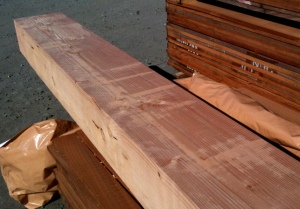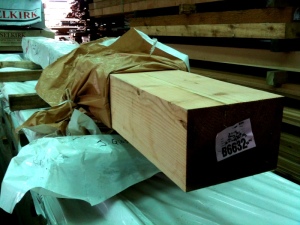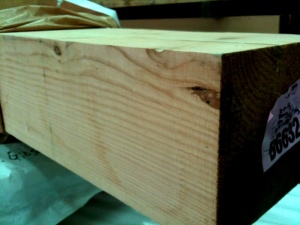Choose Your Hand Plane
I have great respect for contractors who do on site work. I would be a terrible contractor. The minute I’m forced to do some woodworking outside of my shop, everything falls apart. When I’m in my happy womb room (AKA my woodshop) I know where everything is, my workbench can hold anything, and my tools are never more than a few steps from a sharpening stone. When I have to hit the road to do work, I’m constantly over thinking what I will need and inevitably I end up with far too many tools and always missing the one I really need. I’m sure this is just an experience thing and if I had to do more work outside my own shop I would get better. For now however, I’m a hopeless mess.
This afternoon I will be planing a Douglas Fir beam at the J. Gibson McIlvain lumber yard that is too big for any of our moulders and planers in the millworks. It is a custom sized roof beam for a timber framer that is 18 feet long, 10″ thick, and 14″ wide. Because of the non standard size we had to bandsaw it to size. Since the customer is using this in a highly visible space, he does not want the tool marks in evidence. The first thought around the lumber yard was to hit it with a belt sander. Then stupid hand tool freak Director of Marketing had to open his big mouth and suggest that hand planing it would probably be faster and more precise. So guess who is now in charge of cleaning up this timber??
So here I stand in my shop trying to figure out what my weapons of choice will be for this job. Based on the length the jointer plane seems like an obvious choice but I’m not trying to dimension or flatten the beam but really am just removing the saw marks. Wouldn’t a shorter plane more able to follow the contour of the board be faster? However, the added mass of a jointer will keep the plane moving easier over an 18′ long surface.
Perhaps the Jack would be a compromise on the length while still providing some mass to keep the plane in motion. I could adhere to the beam shape better with a 4″ shorter sole.
The thing is I really don’t want to change the shape of this beam any more than I have too. The bandsawn surface is really very clean already so my aim is to set the depth of cut aggressively enough to be able to take a continuous shaving from end to end thus preventing multiple passes that could remove a little more in one spot over another and changing the flatness of the beam. Yes a shorter plane could do this but a heavier cut will be harder to maintain in a lighter plane.
So I’m grabbing my jointer plane and I’ll bring along a block plane and a card scraper in case I need to do any spot work clean up. The reality is that until I put blade to wood I won’t know how my choice will play out.
Do you see why I would be a terrible job site woodworker? I have successfully over analyzed this problem and solved it by not bringing one tool but 3. Is it any wonder I spend my days analyzing market data and website user behavior? Problem solving is fun!
I’ll report back on how my plane choice worked out after I have completed the job…if I still have strength in my arms to type.
 UPDATE 20 MINUTES INTO THE JOB
UPDATE 20 MINUTES INTO THE JOB
Taking a second to catch my breath. The jointer is working out well except that this board is ridiculously out of flat which I should have anticipated better. Basically at every knot the band saw blade deflected slightly causing the whole timber to have a very undulating profile. Here you can see a very nice finished surface where the plane is catching but lots of skip lines where the knots interfere. My block plane is handling the knots quite well but each one has to be tackled individually. I should be able to finish this face with about 30 more minutes work.
It pains me to say it but due to time constraints on this piece we will probably switch to a belt sander for the two edges. I wish I had the time to dedicate to it, because this timber is the perfect hand planing test piece. To get a completely clean surface you will need to employ every trick in the book. So let me go on the record here and say that I believe a more beautiful surface can be had with hand planes, but in the fast paced world of construction where a beam needs to be ready to fit into a roof that will be 25′ over the floor, a belt sander and 100 grit paper will do the job just fine.




